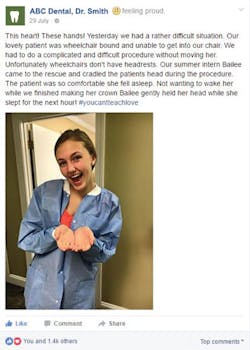What is multichannel dental marketing, and how can I use it to get 170-plus new patients per month?
There's a new buzzword in the dental advertising world—you may have heard it: multichannel marketing. If you’re not a dental marketing expert, you might be wondering what the heck that even means!
Multichannel marketing is when you reach prospective patients through a combination of communication channels, allowing patients to interact with your practice using the channel of their choice. For example: You send a postcard with a free whitening offer that drives people to a landing page where they can claim that offer. At the same time, you run a Facebook ad promoting your free whitening offer. The ad links people directly to your calendar to book an appointment . . .
Get the idea? You’re in front of prospects in multiple places with multiple opportunities to convert - that’s multichannel dental marketing.
Multichannel marketing is a proven way to attract more new patients and improve your marketing return on investment (ROI). And yes, I have proof! But first I want to share some statistics that explain why embracing multiple channels is vital to a successful dental marketing strategy. When it comes to traditional marketing methods, savvy dentists continue to rely on direct mail. Here’s why:
- 54% of consumers prefer to receive promotional material via direct mail.1
- Direct mail garners seven times the response of all digital channels combined.2
- 75% of people could recall a brand after receiving direct mail versus 44% after seeing a digital ad.3
However, you also need to be where your prospects are, and digital platforms present an opportunity that dentists can no longer afford to ignore:
- 73% of Americans go online every day.4
- 21% of Americans are online “almost constantly.” 4
When you combine digital marketing - namely geo-targeted banner ads, which are shown to Internet users in specific geographical areas - with direct mail, results are extremely powerful, as you’re about to see. Here are three successful multichannel dental marketing campaigns from real clients of mine:
Case Study No. 1
This family practice went from 67 to 210 new patients a month by using weekly mailings and Google banner ads. Here’s how they did it:
Postcard campaign - This dentist targeted households within a three-mile radius of his office with direct mail postcards, reaching each recipient three times within three months.
Digital campaign - To amplify the results of his postcard campaign, this dentist ran coordinating geo-targeted Google display ads to prospects in that same area. The ads were visible on literally millions of websites across the Google network.
Campaign results
- $49,000 in immediate revenue
- $260,000 in planned production
- 876% ROI
After eight months of mailing every single week, his practice’s new-patient count increased from 67 to 210!
Case Study No. 2
This practice used direct mail and coordinating online ads to generate $300,000 in revenue.
Postcard campaign - This practice mailed postcards to 22,825 single-family dwellings within a five-mile radius four times over the course of eight months.
Digital campaign - The practice also used coordinating display ads to prospects in that same five-mile radius.
Campaign results
- $300,000 in revenue
- 906% ROI
Case Study No. 3
This dentist achieved an 1,809% ROI with postcards, Google ads, sponsored Facebook posts, and more.
Postcard campaign - This dentist, located in a small town just outside of Washington, DC, mailed 12,000 postcards per month to households with annual incomes of $20,000 or more in surrounding zip codes.
Other traditional marketing channels included ads on the local movie theater screen and local television station.
Digital campaign - In addition to his geo-targeted banner ads, this doctor also placed ads on the local news station’s website, Facebook, and Yelp.
CAMPAIGN Results
- 2,000+ new patients per year
- More than $2,000,000 in annual revenue
- 1,809% ROI
The more you market to your prospects, the more new patients you’ll have coming in - just look at that ROI!
To illustrate my point further, I’d like to tell you a little bit more about the dentist’s marketing story in case study No. 3. Before he started really marketing his practice, he was seeing an average of 30 new patients per month. When he began his direct mail campaign, that number went up to 50. Then he added coordinating Google ads to the mix, and it went up to 94. When he added to this direct mail/Google combination (with Facebook, local movie theater, television, and news website advertising), new patients went up to more than 170!
Overall, that’s a 700% increase in new patients. If that doesn’t convince you that more marketing equals more new patients (and revenue), I don’t know what will. Now, having said that, here’s the bottom line: Very few dentists I’ve met have the kind of time required - after taking care of patients, staff, and office business - to manage multiple marketing channels. One strategy is to combine your direct mail, Google, and Facebook advertising into one campaign with DirectMail2.0, a marketing technique available from select direct mail providers.
Author’s note: Want to boost your new-patient numbers? Visit postcardmania.com/dentaldesigns to see postcard designs that are currently working for other dentists and request a free sample kit!
References
1. Haskel D. 2015 DMA response rate report: direct mail outperforms digital channels combined by nearly 600%. IWCO Direct website. https://www.iwco.com/blog/2015/04/14/dma-response-rate-report-and-direct-mail/. Published April 14, 2015. Accessed May 1, 2017.
2. Cummings C. Consumers know exactly how they want to be marketed to. AdWeek website. http://www.adweek.com/brand-marketing/infographic-consumers-know-exactly-how-they-want-be-marketed-167840/. Published November 1, 2015. Accessed May 1, 2017.
3. Forer L. Head-to-head: direct mail vs. email [infographic]. MarketingProfs website. https://www.marketingprofs.com/chirp/2017/31637/head-to-head-direct-mail-vs-email-infographic. Published April 20, 2017. Accessed May 1, 2017.
4. Perrin A. One-fifth of Americans report going online “almost constantly.” Pew Research website. http://www.pewresearch.org/fact-tank/2015/12/08/one-fifth-of-americans-report-going-online-almost-constantly/. Published December 8, 2015. Accessed May 1, 2017.
Joy Gendusa is the founder and CEO of PostcardMania. Using just postcards, a phone, and a computer, Joy built PostcardMania from a one-person startup into an industry leader. PostcardMania serves 73,792 clients, including 5,330 dentists! E-mail her at [email protected].
About the Author

Joy Gendusa
Founder and CEO, PostcardMania
Joy Gendusa is the founder and CEO of PostcardMania. Using just postcards, a phone, and a computer, Gendusa built PostcardMania from a one-person start-up into an industry leader. PostcardMania serves 102,962 clients, including 6,980 dentists. Need help promoting your practice? Call one of PostcardMania’s dental marketing consultants at (844) 269-1836, or email Gendusa at [email protected].










